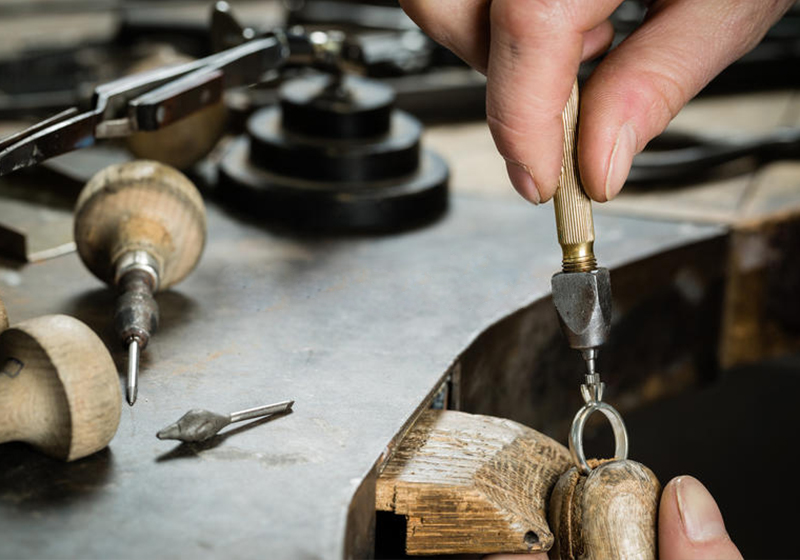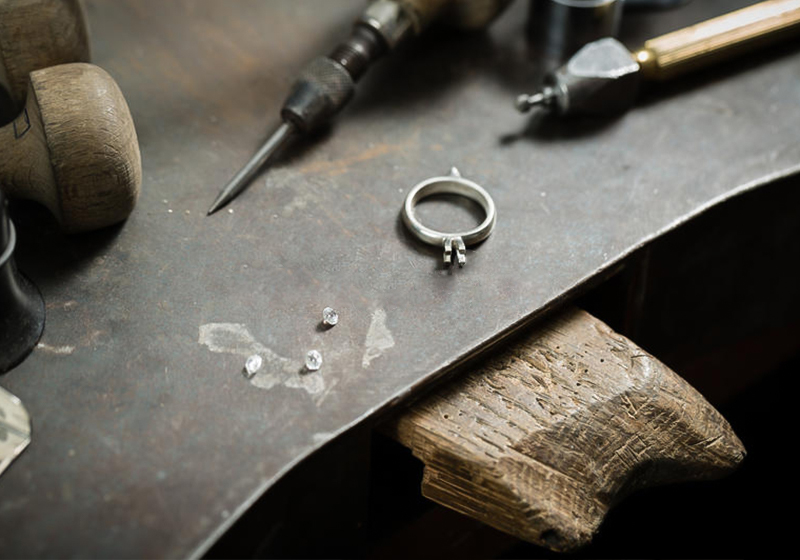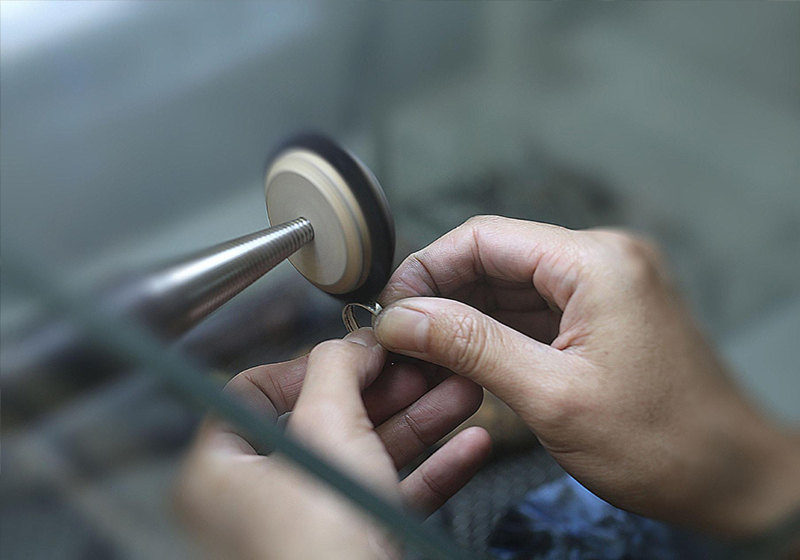An ArticleTo Give You An Idea Of The Jewelry Making Process
August 26,2022
Solid Mounting And Electroforming Processes

The solid setting process refers to the process of using hammers, saws, tongs, files and other tools to forge gold and silver into partial patterns, and file welding into the overall jewelry. This process is sometimes referred to as hand metalwork. The surface of the solid inlaid jewelry is bright, the lines are smooth, the layers are rich, and it is a fine gold craft with good decorative effects near and far, represented by Shanghai, Jiangsu and Zhejiang regions.
Electroforming is a new process of jewelry production, its principle is similar to electroplating, casting in the casting liquid for the negative mold, surface activation treatment after the generation of conductive layer, through electrophoresis the metal will gradually be deposited on the surface of the negative mold, to reach a little thickness can be taken out, polished and welded, surface treatment, become hollow jewelry. This kind of jewelry has a beautiful appearance, large size and light weight, fast electroforming speed, high or low output, and is easy to flexibly master.
At present, the gold ornaments on the market such as mascots, Buddha statues, zodiac signs, etc. are hollow gold jewelry made by electroforming.
Lost Wax Casting Process

Lost wax casting is the main means of industrial production of jewelry at present, which was developed from the ancient casting process. In the late Neolithic period more than 5,000 years ago, ancient craftsmen in China widely used the lost wax casting process in the manufacture of bronze. According to the plasticity and thermal volatilization characteristics of beeswax, the craftsmen at that time first carved the beeswax into a wax mold that needed to be shaped, and then wrapped the clay outside the wax mold and reserved a small hole, dried it and roasted it, so that the wax mold gas volatilized, while the clay became a ceramic shell, that is, to obtain the required metal casting embryo. The principle of modern lost-wax casting is no different from this, but it is more complex and precise.
The general process of lost wax casting is: the original mold is pressed into a silicone mold, the wax mold is injected after the glue mold is opened to obtain a wax mold, the wax mold is planted with wax trees, put into the sleeve to infuse high-temperature gypsum, the gypsum is vacuumed, naturally hardened, dried and cast, the gypsum mold is fried in cold water after the metal is cooled, the casting is soaked with acid after removal, rinsed, the blank is cut for rolling, and then the mold and inlay and surface treatment are carried out.
The casting methods of lost wax casting include vacuum suction casting, centrifugal casting and vicious vacuum centrifugal casting, which are the main means of mass production in the jewelry production industry.
Electroplating Process

Electroplating is a widely used surface processing process, which belongs to a chemical surface treatment process. In the international market, the electroplating process is often used for the surface treatment of K gold jewelry with a content of less than 18K.
The color of the coating is rich, including monochrome plating of various colors such as black, light blue, sauce color, purple, orange red, pink, golden, orange yellow, etc., as well as chromatic plating of multiple colors.
The surface shape of the coating has bright, matte (sandblasting), texture (regular and irregular) and etching to meet the consumer tastes of different consumers.
Plating can also change the color and brightness of jewelry (the plating solution contains a brightener).
The traditional electroplating process is mostly for K gold jewelry plated with pure gold, or after the surface of pure gold jewelry is pressed and brightened, plating with a plating solution with a brightener makes the color and brightness of the jewelry more ideal.
The quality of the process of electroplating is very important, for K gold jewelry, after wear, the original K gold color will be revealed. Therefore, the use of alloy plating to meet the required color, brightness and surface shape at the same time to improve its wear resistance; It can also be treated by means of a protective film on the surface. In conclusion, technology is the deciding factor in the provision of electroplated jewelry. At present, the color of electroplating is no longer the traditional imitation of pure gold, but in line with the taste of fashion color.
The color mark of the electroplated gold jewelry is KGP or KP.
Burnt Blue, Grained Flowers, Carved Gold And Car Flower Craftsmanship

Burning blue: The burning blue process is one of the traditional jewelry crafts in China, because this "blue" can only be fired on the surface of silverware, so it is also called "burning silver blue". The silver-blue color has the transparency of a watercolor painting, which is very interesting. The "blue" of burnt blue is a block material similar to low-temperature glass formed after firing. The process of burning blue: the raw material powder of burning blue is mixed with water, and the blue material is put into the groove of the silver tire with a small spoon, the blue material is flattened, wiped, and the water is sucked by the degreasing cotton and baked in the electric stove, and the blue material is melted and consolidated to form a similar low temperature colored glass attached to the jewelry. The cloisonné process is similar to that of burnt blue, but due to the different composition of the blue material, the "blue" that cloisonné finally forms is not as watercolor-transparent as the burnt blue.
Wycass: The whirlwind process is a metal deformation process that uses a hammer to hit different shapes of the grab knife, forming convex and concave, dark and shallow, or light or hairy lines and patterns, which can be used to express the different materials and textures of the jewelry.
Carving gold: also known as the flower snatching process, and the principle of the flower process is the same, the difference is that the carving gold is carved with different shapes of carving knives, through the push of the palm to carve out a variety of lines and patterns on the metal surface, the surface of the metal part of the shoveled off the light flashing, the carved lines are free and smooth. The gold carving process requires superb manual skills, so the jewelry made in this way is more precious to the craftsmanship.
Turning: Turning is a jewelry machining process that uses diamond milling cutters with different patterns of knife edges to mill the shiny stripes on the surface of jewelry and form various patterns when rotating at high speed. This process is often on K gold and other high hardness jewelry.
Sandblasting, Drawing And Other Processes

Sandblasting: Sandblasting is a process of using quartz sand to form a matte effect on the surface of the jewelry under the action of high-pressure gas.
Drawing: Drawing is a process that uses emery pressing on the surface of the jewelry for directional movement, thereby forming fine metal stripes (Note: the drawing process here is a different concept from the drawing and tableting in the metalworking foundation).
Ginning: The ginning process is often used in the mass production of jewelry. Because the pattern of the jewelry has a certain regularity, it can be processed by hand or mechanically on the steel formwork to produce the required pattern, and then use the stamping machine to stamp the pattern on the metal, cut it and weld it with other parts to become a complete jewelry. Since the ginning process belongs to the plastic processing of the metal surface, the surface of the processed jewelry has undergone plastic deformation, the surface is hard and wear-resistant, bright and durable, and it is not easy to pour light; However, due to the high cost of the complexity of the rigid mold and the change of the color, the ability of the ginning process to adapt to the changing jewelry style of the market needs to be improved.
Etching: The principle of the engraving process is similar to the production of the circuit board, and the processing of the yang pattern is to first coat the metal part to be retained with acid erosion-resistant paint, and use the acid solution to corrode the unwanted metal part; The processing of the yin pattern is the opposite of the processing of the yang pattern. The etching process is suitable for the processing and production of antique crafts and jewelry with special requirements for surface style.